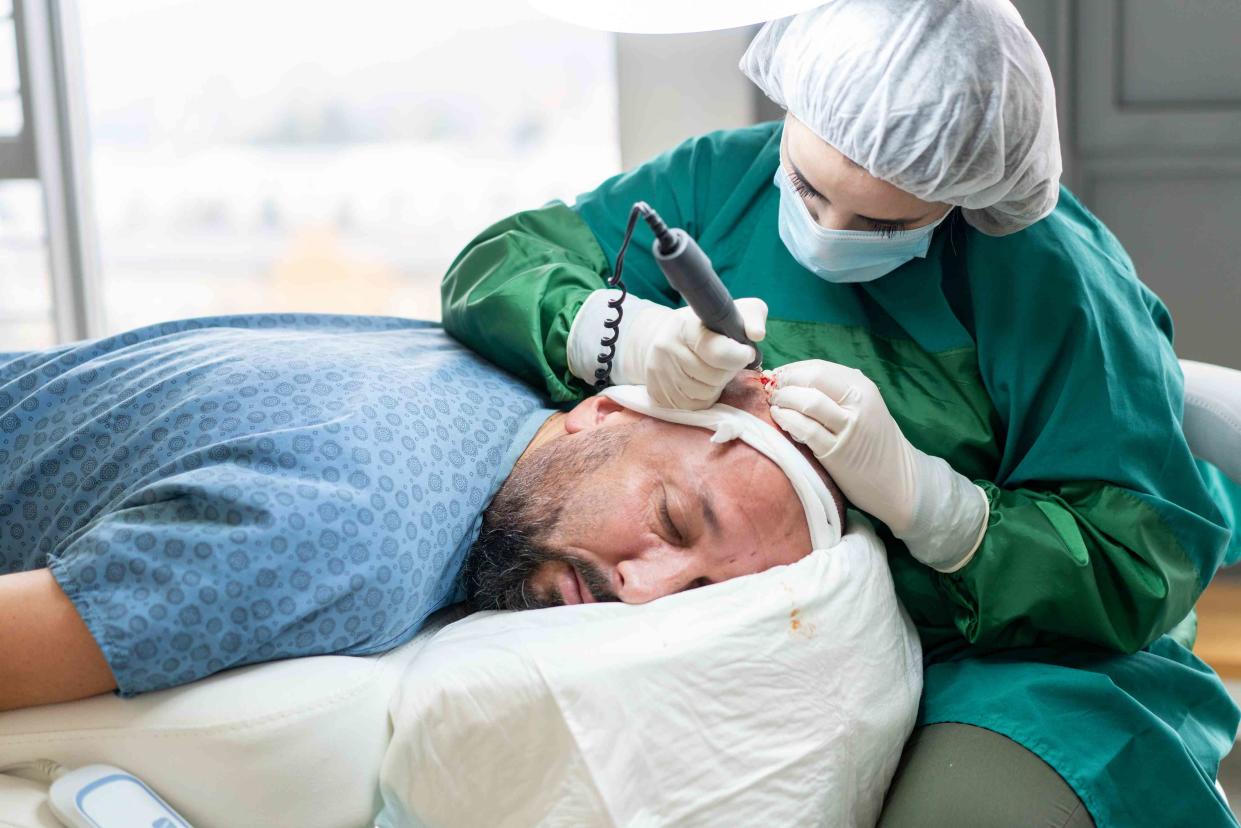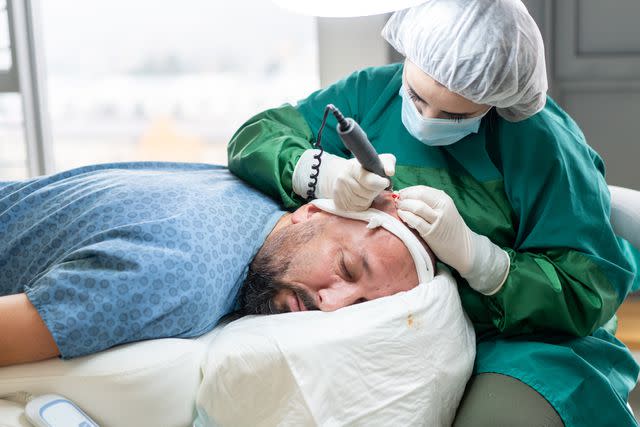Deciding to Have a Hair Transplant

MASTER / Getty Images
Medically reviewed by William Truswell, MD
Hair transplant surgery is also called hair loss surgery or hair restoration surgery. People also refer to hair transplantation as "getting hair implants" or "having a hair transplant." Deciding to have one of these elective surgical procedures is a personal decision.
This article explains how hair transplants work, the financial cost of hair restoration surgery, its side effects, permanence, the potential pain involved with hair transplantation, and other information that will help with your decision-making process.

MASTER / Getty Images
Background Information You Should Know
Male-pattern baldness or female-pattern baldness are known as androgenetic alopecia. The degree of thinning or baldness is measured using different scales for men and women. Male-pattern baldness and hair loss in men are indexed using the Norwood (1–7) scale; hair loss and thinning hair in women are indexed using the Ludwig (types 1–3) classification system.
The number of hair grafts needed for a transplant depends on how much hair loss has occurred, as indicated by the Norwood or Ludwig numbers. For example, a man with a receding hairline indexed at Norwood 2 on the scale who wants to fill in the bald spots around a widow's peak would typically need about 1,000–1,500 grafts to be harvested from the back of his scalp and transplanted up front.
How Does a Hair Transplant Work?
During a hair transplant, local anesthesia is used to numb the pain that occurs as hair grafts are removed and implanted. Each graft uses one to four viable hair follicles removed from an area on the donor's scalp with thicker hair (typically the back) and implanted into bald spots. On average, each transplanted hair graft contains two strands of hair.
Hair transplants work by taking hair follicles from what's considered a donor area where hair tends to be the thickest (usually the back of the scalp) and moving these hairs—that have staying power and will grow throughout a lifetime—to an area on the scalp with less robust hair and where hair has stopped growing.
The current, state-of-the-art surgical hair transplant method is follicular unit extraction (FUE), a harvesting technique that extracts each follicular unit one at a time and with extreme precision and transplants it into an area of the scalp that's balding. Each unit contains one to four hair follicles.
The term "hair plugs for men" is still used conversationally, but the hair transplantation procedure of punch grafting is outdated. The old hair plug method used the equivalent of a surgical cookie cutter (3–4millimeters wide) to harvest and reimplant dozens of hair follicles at a time. The new FUE method creates less scarring than old-fashioned hair plugs because each follicular unit's extraction and transplantation surface area on the scalp is much smaller.
Who Isn't a Good Candidate for Hair Transplant Surgery?
Not everyone is a good candidate for hair transplant surgery. Below are factors to take into consideration when deciding whether to have a hair transplant:
People still experiencing rapid hair loss should wait until their unique male- or female-pattern baldness appears to be permanent and hasn't changed much in at least six months.
To qualify for hair transplant surgery, you need relatively thick hair in your donor area. If your donor supply already shows signs of thinning or miniaturization, transplanted hair follicles won't thrive when relocated.
In general, people under age 25 should wait for hair transplant surgery unless they're seeking hair restoration surgery because of an accident or injury.
Financials: Hair Transplant Cost and Affordability
The cost of hair implants for men or women varies depending on location and each surgeon’s billing rate. Typically, hair transplant costs are based on the number of grafts. In the United States, each graft usually costs about $2 to $10, with a full price of about $12,000.
People traveling overseas to save money on hair restoration surgery is a popular example of medical tourism. When traveling internationally for elective cosmetic surgery, ensure the destination is safe and your surgeon is well-accredited.
Side Effects: Pain After Hair Transplant
Hair transplant surgery is generally safe, but there are some side effects, such as postoperative pain or itchy scalp. During the procedure, local anesthesia is administered to minimize pain. Other postoperative surgical complications might include infection, wound dehiscence (edges of wounds cracking open and no longer meet), skin necrosis (tissue death).
When Do You See Hair Transplant Results?
Because hair transplant surgery usually involves taking very short or shaved hair from the back of the scalp and moving it to a bald spot, you won't start to see results until the transplanted hair has time to regrow. The follicles start to regrow in about three to four months. Most people see results in six to nine months after surgery as the transplanted hair fills in and gets longer. Some surgeons do FUE with longer hair, giving visible results faster.
Permanence of Hair Transplant
Hair transplants are permanent. They may require touch-ups as native hair continues to thin in areas of the scalp prone to hair loss. As people age, male- or female-pattern baldness may progress. It's always wise to save some viable hair grafts in the donor zone at the back of your scalp if you decide to have another hair restoration surgery later in life.
Where to Get a Hair Transplant
The International Alliance of Hair Restoration Surgeons and the International Society of Hair Restoration Surgery are nonprofits with worldwide directories of qualified surgeons.
Hair Transplant Alternatives
Medical therapy using a topical solution like Rogaine (minoxidil) or oral-route Propecia (finasteride) pills are alternative hair loss treatments for people who can't afford hair transplant surgery or want to slow down hair loss without going under the knife.
In 2020, a study found that a low dose of oral minoxidil once daily effectively increased hair growth in study participants with androgenetic alopecia male-pattern baldness. However, this off-label treatment still needs FDA approval as a hair loss prescription.
Summary
Deciding to have a hair transplant is a very personal decision. Hair restoration surgery is expensive and unaffordable for many. Follicular unit extraction (FUE) is a newer method of transplantation that leaves smaller scars than the hair plugs of yesteryear and tends to get the best results with minimal pain. There may be some minor side effects like scalp irritation and pain, but keep an eye out for signs of infection.

